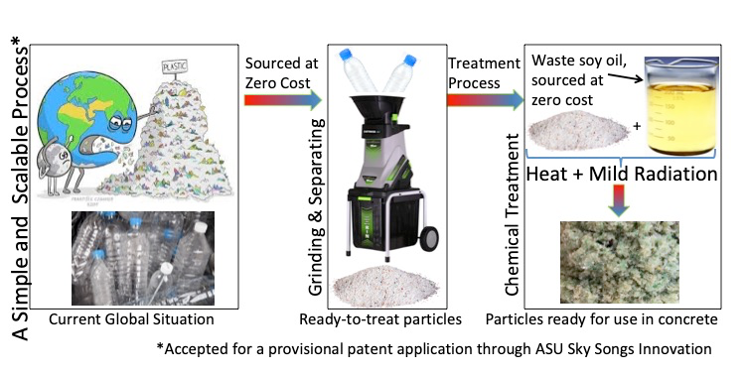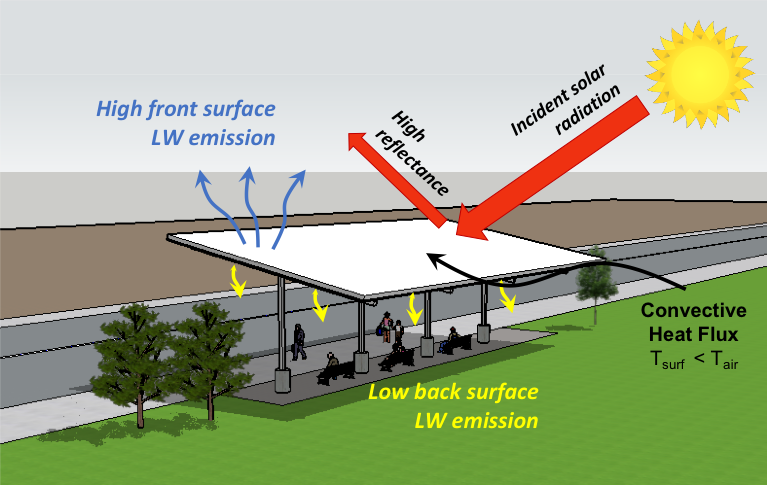
ASU and Zimin Foundation partner for future of urban tech
The new Zimin Institute for Smart and Sustainable Cities will produce and validate technology to improve the sustainability of metropolitan areas globally

Above: Sustainable, smart cities incorporate wide-reaching, interconnected technologies to improve infrastructure, transportation, resource efficiency, health, security and more. The new Zimin Institute for Smart, Sustainable Cities, in partnership with the Zimin Foundation, will help support applied research projects to drive a people-centric vision for the future of cities. Image courtesy of Shutterstock
Cities generate the vibrant energy of society. However, they’re also the center of some of our most pressing sustainability issues — air and water pollution, urban heat islands, disease or security threats, and an increasing demand for resources.
Arizona State University’s main campus is in the heart of the Phoenix metropolitan area — the fifth largest city in the United States. The region surrounding ASU faces similar issues to many of the world’s megacities such as extreme climate and resource limitations. Aware of these challenges, the university has a mission of being socially embedded and leveraging its place to transform society. Researchers in the Ira A. Fulton Schools of Engineering and many other schools at ASU are employing an entrepreneurial mindset and applied, use-inspired research to engineer and validate solutions that serve communities.
Sustainable, smart city technologies represent a unique opportunity to create solutions that advance urban areas and the well-being of their inhabitants by addressing the potentially harmful effects of the built environment.
An opportunity to work with the most innovative university on smart city technology was the impetus for the Zimin Foundation to partner with and support ASU and the Fulton Schools on the second international Zimin Institute, focusing on future technologies that enable smart and sustainable cities.
“The selection reflects on ASU’s growing reputation as an innovation powerhouse and an agent for positive societal change and impact,” says Kyle Squires, dean of the Fulton Schools.
“With this gift, the new Institute has a tremendous opportunity to energize the ASU community of scholars and innovators to lead the creation of new smart city technology solutions, to catalyze new active collaborations with regional stakeholder public and private partners and ultimately to be a world leader in the smart and sustainable cities arena.”
Zimin Foundation provides resources to advance society through innovation
The Zimin family has historically focused its philanthropic efforts on supporting science and education in Russia. Their not-for-profit organization, the Zimin Foundation, recently extended its activities to other countries, with the first Zimin Institutes established at Tel Aviv University in 2018 and now ASU in 2020.
“The Zimin Foundation and ASU share the vision of achieving high impact by supporting projects with visible real-world effects,” says Mark Shmulevich, head of Zimin Institutes at the Zimin Foundation. “ASU will be able to match the experience of their researchers and their research partners with the opportunities to quickly apply sustainability and smart city innovations.”
The vision of the Zimin Institute for Smart and Sustainable Cities at ASU is to drive people-centric smart cities of the future — integrating advanced technologies into the physical spaces where people live, work, learn and play to enhance security, health, sustainability and resilience.
The first challenge of creating smart, sustainable cities is their wide-ranging, difficult-to-define yet appealing promise, says Gregory Raupp, director of the new Zimin Institute for Smart and Sustainable Cities at ASU and Fulton Schools Foundation Professor of chemical engineering. With so many components and stakeholders, Raupp says “the only logical and effective strategy to address the challenges is through a combination of targeted, use-inspired research leading to technological innovation and collaboration between public organizations and private enterprises.”
“A city, smart or otherwise, is an incredibly complex system of systems of systems,” Raupp says. “We must integrate and weave all of the technology solutions into a cohesive fabric that works seamlessly and effectively to make a genuinely smart city, one that increases the level of health, happiness, contentment and personal enrichment of all its citizens — a place where we would all want to live.”
The new Zimin Institute at ASU will identify transformative technologies, connect researchers for interdisciplinary collaboration, fund nascent technology solutions, leverage ASU and local innovative testbeds and initiatives, grow the smart cities entrepreneurial ecosystem through venture funding, and engage with the community and stakeholders to ensure solutions coming out of the institute create value.
“The Zimin Institute at ASU will financially support several projects every year on a competitive basis,” Shmulevich says. “It will also allow the project teams to tap into the Zimin Foundation network of researchers, tech experts and laboratories. We believe that interdisciplinary teams of researchers often generate the best innovations. We strongly encourage such collaboration. The most successful projects will be able to tap on the Zimin Foundation support in the later stages of their innovation journey.”
In 2020, projects of interest focus on human connection, sustainable and healthy environments, public safety and well-being, and infrastructure resilience. The Zimin Institute is open to consider supporting compelling new projects that may be considered too risky for conventional funding avenues.
Raupp is pleased with the first four projects that have been selected for support by the Zimin Institute Technical Advisory and Executive Advisory Boards. They address multiple facets of the future smart cities, from sustainable building materials, the urban heat island and air quality to support for people living with Alzheimer’s disease and their caregivers.
“These projects are all tackling immensely important problems that are, unfortunately, growing in their scale and intensity,” Raupp says. “In addition, it is gratifying to see that the projects cement new, exciting collaborations with external organizations.”
The selected projects are at a diverse range of stages from visioning and ideation to technology prototypes and field testing.
“It’s a great start,” says Boris Zimin, chairman of the Zimin Foundation. “Our vision is to be able to support the most promising innovation projects that bring lab findings into the world, helping people globally. We wish the best of luck to the first winners of our grant call at ASU and will keep doing our best supporting them.”
Making concrete more sustainable

Assistant Professor Christian Hoover and Associate Professor Elham Fini are developing a process to use plastics diverted from landfills to create more sustainable concrete. Image courtesy of Christian Hoover and Elham Fini
Two faculty members from the School of Sustainable Engineering and the Built Environment are working to make the production of concrete more environmentally friendly by using waste plastics, reducing the carbon footprint of concrete ingredients and reducing the weight of concrete.
“Treated Waste Plastics: A Solution for Enhancing Performance of Concrete Construction” is directed by Christian Hoover, an assistant professor of structures, with co-principal investigator Elham Fini, an associate professor of construction, civil and environmental engineering, senior sustainability scientist and director of the International Innovation Network for Construction Materials, Methods and Management, or ICM3.
Plastics diverted from landfills can be ground up and heat-treated so they can chemically bond with cement to create concrete that is tension-resistant and lightweight as it reduces the demand for steel reinforcement. Hoover and Fini’s process for achieving this environmentally-friendly concrete has been accepted for a provisional patent application through ASU Skysong Innovation.
Support for the project will help Hoover and Fini optimize the procedure for treating waste plastic and the amount of plastic particles in concrete mixtures for best performance.
Monitoring air pollution for better community health

Assistant Research Professor Samuel Markolf is using a network of sensors on light rail trains to monitor Phoenix air quality for mitigation efforts and improved community health. Image courtesy of Samuel Markolf
Samuel Markolf, an assistant research professor of civil and environmental engineering in the School of Sustainable Engineering and the Built Environment, leads a project to help improve Phoenix residents’ health, especially in underrepresented and underserved communities. In his project, Markolf will conduct environmental monitoring by placing a network of sensors on light rail trains.
“Observing Human-Scale Urban Air Pollution and Temperature Using Sensor-Embedded Light-Rail Public Transportation” proposes to monitor and evaluate temperature, humidity and air quality factors such as particulate matter and ozone at a high temporal and spatial resolution in the Phoenix metro area. This allows for the identification of “trouble spots” for more targeted mitigation strategies and supplements existing county-wide monitoring.
Funding from the Zimin Institute will help Markolf determine the benefits of low-cost, rapidly deployable sensors to understand local conditions.
Helping people with dementia and their caregivers with robots

A series of illustrations demonstrates the uses for a storytelling robot in the role of caregiving for older adults who have dementia. Assistant Professor Troy McDaniel is testing different human-robot interfaces to help mitigate negative effects of dementia for both people with the condition and their caregivers. Image courtesy of Troy McDaniel
Troy McDaniel, an assistant professor of engineering in The Polytechnic School, is exploring the use of storytelling robots to care for people with dementia and contribute to the future of in-home caregiving in smart city environments.
“Storytelling Robots to Assist Older Adults with Dementia and Their Caregivers” builds on the Alzheimer’s Association’s recommendation to engage in storytelling arts and conversations to combat the negative effects of dementia. Storytelling can promote a sense of accomplishment, raise self-esteem, improve creative and verbal skills, improve social interaction, provide therapeutic communication opportunities and replace the pressure to remember.
In addition to alleviating depression, isolation and aggression in people who have dementia, McDaniel’s approach also supports caregivers, who often report high levels of stress, depression and financial and physical difficulties. By encouraging patient interaction with a robot, human caregivers can take time to accomplish other tasks or take personal time for their own mental and physical health, including robot-guided meditation and breathing exercises.
Zimin Institute support will allow McDaniel to test different human-robot interfaces to address depression, isolation and stress in older adults with dementia and their caregivers.
Developing urban cooling strategies for a hot metropolis

Professor David J. Sailor and Assistant Professor Ariane Middel are testing an urban cooling solution that uses a passive, radiative heat pump surface applied on bus stop shelters that can cool the surrounding area. The researchers also plan to track heat variations across Phoenix with a sensor network integrated into mass transit infrastructure. Image courtesy of David J. Sailor and Ariane Middel
David J. Sailor, a professor in the ASU School of Geographical Sciences and Urban Planning, leads an urban cooling project with Ariane Middel, an assistant professor jointly appointed in the School of Computing, Informatics, and Decision Systems Engineering and the School of Arts, Media and Engineering and a member of the Urban Climate Research Center, and Richard R. King, a professor of electrical engineering in the School of Electrical, Computer and Energy Engineering.
“Passive Radiative Heat Pump Surfaces for Urban Cooling” addresses urban waste heat emissions from infrastructure building materials. Sailor, Middel and King are partnering with the city of Tempe and 3M to evaluate a new radiative film technology. The film can passively cool the surrounding area by removing heat from the air and sending it away from the urban environment, often into outer space. The technology will be installed on Tempe bus shelters.
The second element of their project tracks heat variations across the city with an RFID-based sensor network integrated into mass transit infrastructure.
Zimin Institute backing for this project will help the research team generate proof-of-concept data from living laboratories. This is essential to create and implement strategies that overcome cost, technical, political and institutional barriers that often prevent new technologies from being implemented in cities.
Continuing support for applied research solutions
The Zimin Foundation leaders look forward to what will happen through these projects in the next few years. Foundation representatives will regularly interact with the project researchers and introduce them to their network, enabling the teams to learn and share best practices of translating research into real-world use.
When these four projects reach the prototyping phase or the researchers want to create spinoffs from their research, the Zimin Foundation will consider extending its support.
“We plan to hold three selection cycles and then an in-depth review of the progress of all the supported projects,” Shmulevich says.
Zimin Foundation support is not limited to engineering researchers — faculty members from across ASU can apply for Zimin Institute funding with projects at any stage of development. The Institute will prioritize solutions headed toward implementation, deployment or commercialization within five years.
“The Zimin Institute at ASU provides a unique funding opportunity that’s intended to bridge gaps in translating research to commercialization, essentially to fund new, exciting ideas and solutions for which it might otherwise be difficult to secure additional funding, while establishing new, productive collaborations and partnerships,” Raupp says. “Any professor looking for a path to commercialization for their smart cities research is welcome to apply for funding.”
Faculty members interested in applying for Cohort II funding can visit zimin-institute.asu.edu for more information, or contact Project Manager Lisa Irimata at [email protected] or Zimin Institute Director Greg Raupp at [email protected] for specific questions.



































